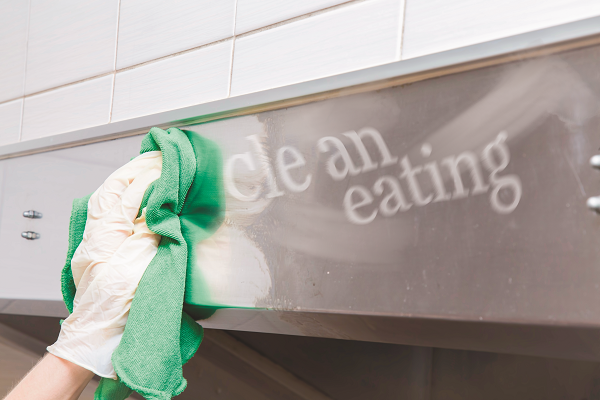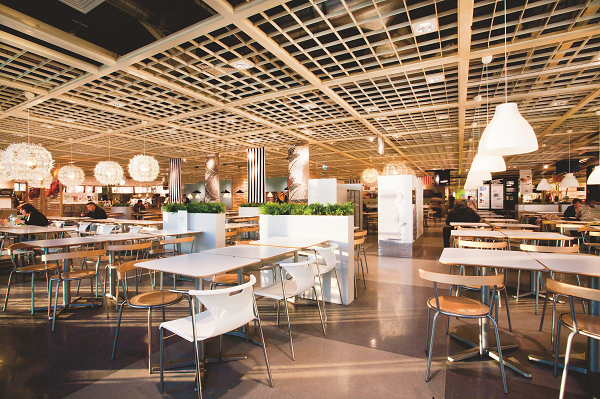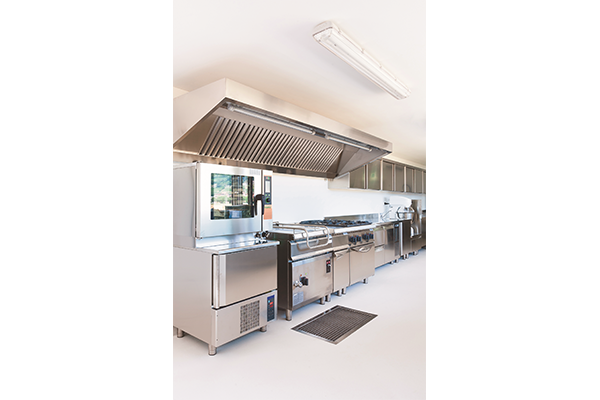Retailers adding foodservice to their stores face unique cleaning challenges.
In retail, a dirty store can lead to a sullied brand. In foodservice, however, the consequences can be much more dire, according to the Johns Hopkins Bloomberg School of Public Health. In 2018, it conducted a study to determine the total costs of foodborne illness outbreaks in restaurants from 2010 to 2015. It found that when accounting for lost revenue, lawsuits, legal fees and fines, a single outbreak of foodborne illness affecting 250 people can cost upwards of $2.5 million.
As more and more retailers add foodservice operations to their stores — everything from cafes and cafeterias to quick- and full-service restaurants — it’s clear: facility managers in hybrid settings must make cleaning a top priority.
“Cleanliness is obviously important for brand image and appearance. But when it comes to foodservice, there also are federal and state guidelines that create expectations most retailers probably aren’t used to,” said Amanda Smith, National Sales Executive at Superclean Service Company, a commercial cleaning business. “For that reason, having a top-notch cleaning program is paramount.”
According to Smith, successful cleaning in foodservice settings hinges on having the correct supplies and the right strategies. The following tips can help retail facility managers (FMs) acquire both — avoiding a mess in more ways than one.
1. Raise your equipment IQ.
Although there are many differences between retail and restaurant spaces, the most obvious one from a maintenance perspective is the equipment. Along with making sure floors, surfaces and bathrooms are clean, retail FMs in foodservice settings must also consider specialized items like cooking ranges, ice makers, espresso machines and grease traps, all of which have unique cleaning requirements.
“Exhaust hoods, for instance, are really important for fire safety [in commercial kitchens]. Hoods generally require preventive maintenance or break-fix support, and that typically falls underneath the facility manager’s realm of responsibilities,” Smith explained. She added that FMs might need to source new vendors or conduct new training to ensure proper cleaning and maintenance of specialized foodservice equipment.
2. Increase your cleanser comprehension.
In foodservice settings, it’s especially important to understand when you should sanitize versus when you should disinfect.
“Sanitizers are agents that sit on the surface for 30 seconds and kill 99.9 percent of bacteria, whereas disinfectants destroy 100 percent of organisms but generally need around 10 minutes of dwell time,” Smith said. “When you need to kill as many germs as possible in a short amount of time, that’s when you use sanitizers — so things like countertops or floors that you come in constant contact with and need to clean regularly throughout the day. On the other hand, you must disinfect restrooms, because there’s a risk of cross-contamination that can lead to dirty eating utensils, condiments — all kinds of things.”
3. Avoid cross-contamination.
Preventing cross-contamination should be a major priority for retail FMs with foodservice responsibilities, according to Smith. She explained that an easy yet effective way to prevent germ migration is to have different sets of cleaning equipment for different foodservice “zones.”
“You need one set of cleaning equipment for the front of the house and one for the back of the house. You don’t want to drag kitchen grease from the kitchen to the dining room by using the same mop head,” Smith said. “The same thing applies to restrooms; you don’t want to be cleaning the restrooms and then use the same equipment and utensils to clean the kitchen.”
Color-coding can help. “You can have different colored mop heads for the front and back of the house, and different colored mop buckets or wringers. I’ve even seen people place duct tape on one set of equipment to indicate it’s for a separate area.”
4. Mind your moisture.
Because of spills, foodservice tends to see a lot of wet mopping, which, Smith explained, can lead to lots of “soil and slosh” on baseboards and walls. For that reason, she said, it’s important to routinely clean baseboards and walls up to 8 inches off the floor.
But cleaning and maintenance staff must be careful not to waterlog foodservice areas. “Many times, people cleaning kitchen floors will deck-brush them, then rinse them with a hose,” Smith explained. “If you have fire-resistant panel walls, that’s acceptable. But if you have drywall, you must be sure you’re not over-wetting. That can lead to mold.”
It also can lead to slips and falls, which are “definitely an added risk” in foodservice settings, Smith pointed out.
5. Optimize cleaning routines.
To make cleaning simultaneously more effective, efficient and affordable, avoid one-size-fits-all cleaning routines in favor of custom programs. Among the things you should consider are:
- Foodservice segment: In quick-service settings, there is typically large amounts of grease. In full-service settings, there are large dining rooms to clean. Each has unique attributes that should influence when and how you clean, which in turn can impact budget and staffing needs, Smith said.
- Soil loads: Retail FMs should optimize cleaning frequency by looking at store-level factors such as foot traffic, sales volume, geography and climate, all of which can impact soil loads. Urban and wintry locations, for example, generally have higher soil loads than suburban and Sun Belt locations. Customizing cleaning programs based on soil load can prevent overspending, according to Smith.
- Surface types: Cleaning programs should take into account what types of surfaces need to be cleaned. For instance, commercial kitchens often are clad in stainless steel. According to Smith, the best cleanser for stainless steel is simple soap and water; expensive specialty cleansers are unnecessary. In addition to using the right cleansers for the job, use the right amounts. Smith advised that more isn’t necessarily better, and using proper measurements ensures supplies work well and last long.
6. Hire a qualified cleaning partner.
According to Smith, cleaning contractors can help retail FMs navigate the differences between retail and foodservice, whether they’re contracted for routine cleaning every day, deep cleaning on an episodic or periodic basis, or merely consulting at the inception of a new cleaning program. Smith advised that it’s important to hire someone with prior experience in foodservice spaces comparable to yours in size and segment (e.g., quick-service, fast-casual, full-service, fine-dining).
“First-hand experience in your specific setting is key, because foodservice settings can be vastly different.” Smith said. Her final piece of advice? Pivot from a responsive to preventive mindset. “In retail, cleaning tends to be reactive — if something’s dirty, you clean it. But in foodservice, you have to be proactive.”






